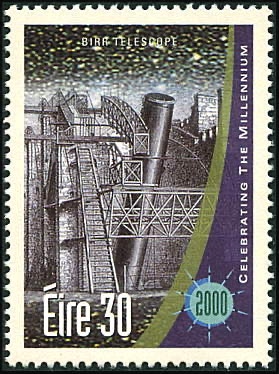2000 Birr Telescope (Éire)
Before the 100-inch (2.5-m) reflector on Mount Wilson, California, opened in 1917, the world’s largest telescope was the so-called Leviathan of Parsonstown, built by William Parsons, third Earl of Rosse, at his home in Birr Castle, Ireland. This monumental instrument consisted of a tube 17m long suspended between two stone walls 15 m high. The tube could move freely in a vertical direction, but was restricted in horizontal movement by the walls so that the viewing time on any particular object was never more than about 2 hours. The telescope had a polished metal mirror 72 inches (1.83 m) in diameter, made by Rosse. In fact there were two mirrors, one being repolished while the other was in use, because the metal alloy tarnished quickly.
Lord Rosse’s telescope took three years to build and came into operation in 1845. It quickly established that certain so-called nebulae were spiral in shape – what we now term galaxies – while others were clusters of stars. The first object confirmed to have spiral structure was M51, the Whirlpool Galaxy, in April 1845.
His studies were continued by his son, Laurence Parsons, the fourth Earl, but after Laurence’s death in 1908 the telescope was largely dismantled. It was restored by the present Earl in the late 1990s and in 1999 was fitted with a new mirror. Unlike the heavy and easily tarnished metal alloy used by Rosse, the new mirror is made of aluminium. It was cast in France, and ground and polished in the Optical Science Laboratory at University College, London.
This stamp showing the Birr Telescope in its prime was issued by Éire in 2000 as part of a millennium set commemorating discoveries.
Stanley Gibbons no. 1301
